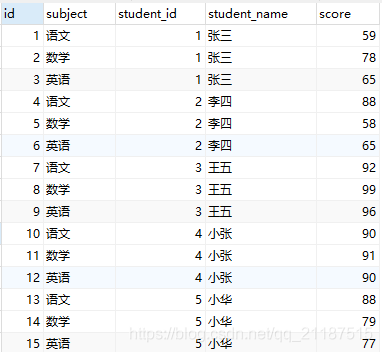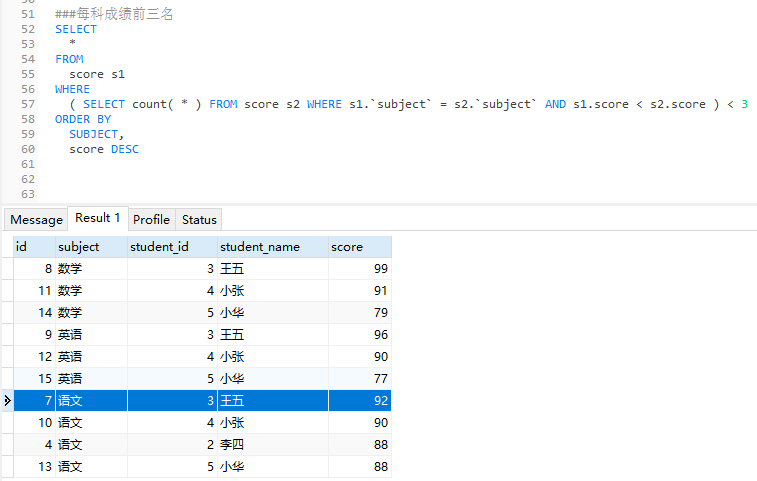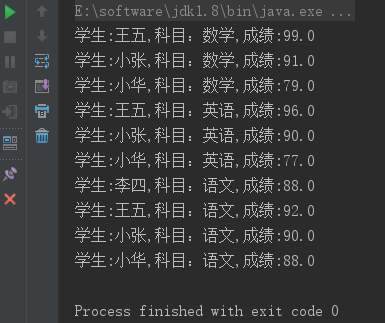 Database
Database
 Mysql Tutorial
Mysql Tutorial
 Mysql implements how to write sql to obtain the top few in each group after distinguishing by group
Mysql implements how to write sql to obtain the top few in each group after distinguishing by group
Mysql implements how to write sql to obtain the top few in each group after distinguishing by group
Encountered a scenario where I need to group the data and then get the first 10 pieces of data in each group. First I thought of using group by, but the difficulty is how to know the data after grouping. The data is ranked in the group.
1. Create a table and insert relevant test data
CREATE TABLE `score` ( `id` int(11) NOT NULL AUTO_INCREMENT COMMENT '主键', `subject` varchar(20) DEFAULT NULL COMMENT '科目', `student_id` int(11) DEFAULT NULL COMMENT '学生id', `student_name` varchar(20) NOT NULL COMMENT '学生姓名', `score` double DEFAULT NULL COMMENT '成绩', PRIMARY KEY (`id`) ) ENGINE=InnoDB AUTO_INCREMENT=16 DEFAULT CHARSET=utf8;

Note: The inserted data sql is at the end, friends can verify the following by themselves sql
2. Query the records of the top three scores in each subject
Now that the data is available, write the sql. The sql is as follows:
###每科成绩前三名 SELECT * FROM score s1 WHERE ( SELECT count( * ) FROM score s2 WHERE s1.`subject` = s2.`subject` AND s1.score < s2.score ) < 3 ORDER BY SUBJECT, score DESC

Analysis:
A subquery is used in it, and the core sql is the condition after where:
( SELECT count( * ) FROM score s2 WHERE s1.subject = s2.subject AND s1.score < s2.score ) < 3
The meaning of this sql is. . .
I feel like my language is a bit difficult to describe, so I will use the java code I am familiar with to describe the above sql. It is probably a for loop that traverses twice, and the same subject is counted in the second for loop. Student records, the number of students with higher scores than s1. If this number is less than 3, it means that s1 ranks in the top three. Look at the following code to understand
public class StudentTest {
public static void main(String[] args) {
List<Student> list = new ArrayList<>();
//初始化和表结构一致的数据
initData(list);
//记录查询出来的结果
List<Student> result = new ArrayList<>();
for(Student s1 : list){
int num = 0;
//两次for循环遍历,相当于sql里面的子查询
for(Student s2:list){
//统计同一科目,且分数s2分数大于s1的数量,简单理解就是同一科目的学生记录,比s1的学生分数高的数量
if(s1.getSubject().equals(s2.getSubject())
&&s1.getScore()<s2.getScore()){
num++;
}
}
//比s1的学生分数高的数量,如果小于3的话,说明s1这个排名前三
// 举例:num=0时,说明同一科目,没有一个学生成绩高于s1学生, s1学生的这科成绩排名第一
// num =1,时,s1学生排名第二,num=3时:说明排名同一科目有三个学生成绩高过s1,s1排第四,所以只统计前三的学生,条件就是num<3
if(num < 3){
result.add(s1);
}
}
//输出各科成绩前三的记录
result.stream()
.sorted(Comparator.comparing(Student::getSubject))
.forEach(
s-> System.out.println(String.format("学生:%s,科目:%s,成绩:%s",s.getName(),s.getSubject(),s.getScore()))
);
}
public static void initData(List<Student> list) {
list.add(new Student(1,"语文","张三",59));
list.add(new Student(2,"数学","张三",78));
list.add(new Student(3,"英语","张三",65));
list.add(new Student(4,"语文","李四",88));
list.add(new Student(5,"数学","李四",58));
list.add(new Student(6,"英语","李四",65));
list.add(new Student(7,"语文","王五",92));
list.add(new Student(8,"数学","王五",99));
list.add(new Student(9,"英语","王五",96));
list.add(new Student(10,"语文","小张",90));
list.add(new Student(11,"数学","小张",91));
list.add(new Student(12,"英语","小张",90));
list.add(new Student(13,"语文","小华",88));
list.add(new Student(14,"数学","小华",79));
list.add(new Student(15,"英语","小华",77));
}
@Data
public static class Student {
private int id;
private String subject;
private String name;
private double score;
//想当于表结构
public Student(int id, String subject, String name, double score) {
this.id = id;
this.subject = subject;
this.name = name;
this.score = score;
}
}You can see the results and execution printed out after the code is run. The result after sql is the same

SELECT * FROM score WHERE student_id IN (SELECT student_id FROM score GROUP BY student_id HAVING min( score ) >= 90 )
SELECT * FROM score WHERE student_id NOT IN (SELECT student_id FROM score GROUP BY student_id HAVING max( score ) < 90 )
Note: Forward and reverse options depend on the specific situation
Other narration
Query the records of students whose average score in each subject is greater than 80 points###查询学生各科平均分大于80分的记录
select * from score where student_id in(
select student_id from score GROUP BY student_id HAVING avg(score)>80
)###查询一个学生每科分数不及格的记录 SELECT * FROM score WHERE student_id IN ( SELECT student_id FROM score GROUP BY student_id HAVING max( score ) < 60 )
CREATE TABLE `score` ( `id` int(11) NOT NULL AUTO_INCREMENT COMMENT '主键', `subject` varchar(20) DEFAULT NULL COMMENT '科目', `student_id` int(11) DEFAULT NULL COMMENT '学生id', `student_name` varchar(20) NOT NULL COMMENT '学生姓名', `score` double DEFAULT NULL COMMENT '成绩', PRIMARY KEY (`id`) ) ENGINE=InnoDB AUTO_INCREMENT=16 DEFAULT CHARSET=utf8; INSERT INTO `test`.`score`(`id`, `subject`, `student_id`, `student_name`, `score`) VALUES (1, '语文', 1, '张三', 59); INSERT INTO `test`.`score`(`id`, `subject`, `student_id`, `student_name`, `score`) VALUES (2, '数学', 1, '张三', 78); INSERT INTO `test`.`score`(`id`, `subject`, `student_id`, `student_name`, `score`) VALUES (3, '英语', 1, '张三', 65); INSERT INTO `test`.`score`(`id`, `subject`, `student_id`, `student_name`, `score`) VALUES (4, '语文', 2, '李四', 88); INSERT INTO `test`.`score`(`id`, `subject`, `student_id`, `student_name`, `score`) VALUES (5, '数学', 2, '李四', 58); INSERT INTO `test`.`score`(`id`, `subject`, `student_id`, `student_name`, `score`) VALUES (6, '英语', 2, '李四', 65); INSERT INTO `test`.`score`(`id`, `subject`, `student_id`, `student_name`, `score`) VALUES (7, '语文', 3, '王五', 92); INSERT INTO `test`.`score`(`id`, `subject`, `student_id`, `student_name`, `score`) VALUES (8, '数学', 3, '王五', 99); INSERT INTO `test`.`score`(`id`, `subject`, `student_id`, `student_name`, `score`) VALUES (9, '英语', 3, '王五', 96); INSERT INTO `test`.`score`(`id`, `subject`, `student_id`, `student_name`, `score`) VALUES (10, '语文', 4, '小张', 90); INSERT INTO `test`.`score`(`id`, `subject`, `student_id`, `student_name`, `score`) VALUES (11, '数学', 4, '小张', 91); INSERT INTO `test`.`score`(`id`, `subject`, `student_id`, `student_name`, `score`) VALUES (12, '英语', 4, '小张', 90); INSERT INTO `test`.`score`(`id`, `subject`, `student_id`, `student_name`, `score`) VALUES (13, '语文', 5, '小华', 88); INSERT INTO `test`.`score`(`id`, `subject`, `student_id`, `student_name`, `score`) VALUES (14, '数学', 5, '小华', 79); INSERT INTO `test`.`score`(`id`, `subject`, `student_id`, `student_name`, `score`) VALUES (15, '英语', 5, '小华', 77);
The above is the detailed content of Mysql implements how to write sql to obtain the top few in each group after distinguishing by group. For more information, please follow other related articles on the PHP Chinese website!

Hot AI Tools

Undresser.AI Undress
AI-powered app for creating realistic nude photos

AI Clothes Remover
Online AI tool for removing clothes from photos.

Undress AI Tool
Undress images for free

Clothoff.io
AI clothes remover

AI Hentai Generator
Generate AI Hentai for free.

Hot Article

Hot Tools

Notepad++7.3.1
Easy-to-use and free code editor

SublimeText3 Chinese version
Chinese version, very easy to use

Zend Studio 13.0.1
Powerful PHP integrated development environment

Dreamweaver CS6
Visual web development tools

SublimeText3 Mac version
God-level code editing software (SublimeText3)

Hot Topics
 PHP's big data structure processing skills
May 08, 2024 am 10:24 AM
PHP's big data structure processing skills
May 08, 2024 am 10:24 AM
Big data structure processing skills: Chunking: Break down the data set and process it in chunks to reduce memory consumption. Generator: Generate data items one by one without loading the entire data set, suitable for unlimited data sets. Streaming: Read files or query results line by line, suitable for large files or remote data. External storage: For very large data sets, store the data in a database or NoSQL.
 How to optimize MySQL query performance in PHP?
Jun 03, 2024 pm 08:11 PM
How to optimize MySQL query performance in PHP?
Jun 03, 2024 pm 08:11 PM
MySQL query performance can be optimized by building indexes that reduce lookup time from linear complexity to logarithmic complexity. Use PreparedStatements to prevent SQL injection and improve query performance. Limit query results and reduce the amount of data processed by the server. Optimize join queries, including using appropriate join types, creating indexes, and considering using subqueries. Analyze queries to identify bottlenecks; use caching to reduce database load; optimize PHP code to minimize overhead.
 How to use MySQL backup and restore in PHP?
Jun 03, 2024 pm 12:19 PM
How to use MySQL backup and restore in PHP?
Jun 03, 2024 pm 12:19 PM
Backing up and restoring a MySQL database in PHP can be achieved by following these steps: Back up the database: Use the mysqldump command to dump the database into a SQL file. Restore database: Use the mysql command to restore the database from SQL files.
 How to insert data into a MySQL table using PHP?
Jun 02, 2024 pm 02:26 PM
How to insert data into a MySQL table using PHP?
Jun 02, 2024 pm 02:26 PM
How to insert data into MySQL table? Connect to the database: Use mysqli to establish a connection to the database. Prepare the SQL query: Write an INSERT statement to specify the columns and values to be inserted. Execute query: Use the query() method to execute the insertion query. If successful, a confirmation message will be output.
 How to fix mysql_native_password not loaded errors on MySQL 8.4
Dec 09, 2024 am 11:42 AM
How to fix mysql_native_password not loaded errors on MySQL 8.4
Dec 09, 2024 am 11:42 AM
One of the major changes introduced in MySQL 8.4 (the latest LTS release as of 2024) is that the "MySQL Native Password" plugin is no longer enabled by default. Further, MySQL 9.0 removes this plugin completely. This change affects PHP and other app
 How to use MySQL stored procedures in PHP?
Jun 02, 2024 pm 02:13 PM
How to use MySQL stored procedures in PHP?
Jun 02, 2024 pm 02:13 PM
To use MySQL stored procedures in PHP: Use PDO or the MySQLi extension to connect to a MySQL database. Prepare the statement to call the stored procedure. Execute the stored procedure. Process the result set (if the stored procedure returns results). Close the database connection.
 How to create a MySQL table using PHP?
Jun 04, 2024 pm 01:57 PM
How to create a MySQL table using PHP?
Jun 04, 2024 pm 01:57 PM
Creating a MySQL table using PHP requires the following steps: Connect to the database. Create the database if it does not exist. Select a database. Create table. Execute the query. Close the connection.
 The difference between oracle database and mysql
May 10, 2024 am 01:54 AM
The difference between oracle database and mysql
May 10, 2024 am 01:54 AM
Oracle database and MySQL are both databases based on the relational model, but Oracle is superior in terms of compatibility, scalability, data types and security; while MySQL focuses on speed and flexibility and is more suitable for small to medium-sized data sets. . ① Oracle provides a wide range of data types, ② provides advanced security features, ③ is suitable for enterprise-level applications; ① MySQL supports NoSQL data types, ② has fewer security measures, and ③ is suitable for small to medium-sized applications.





